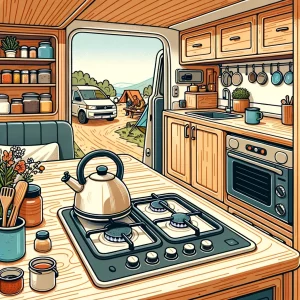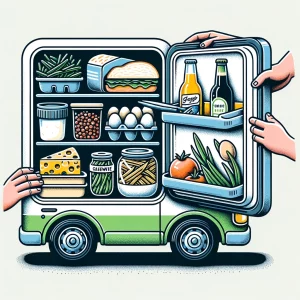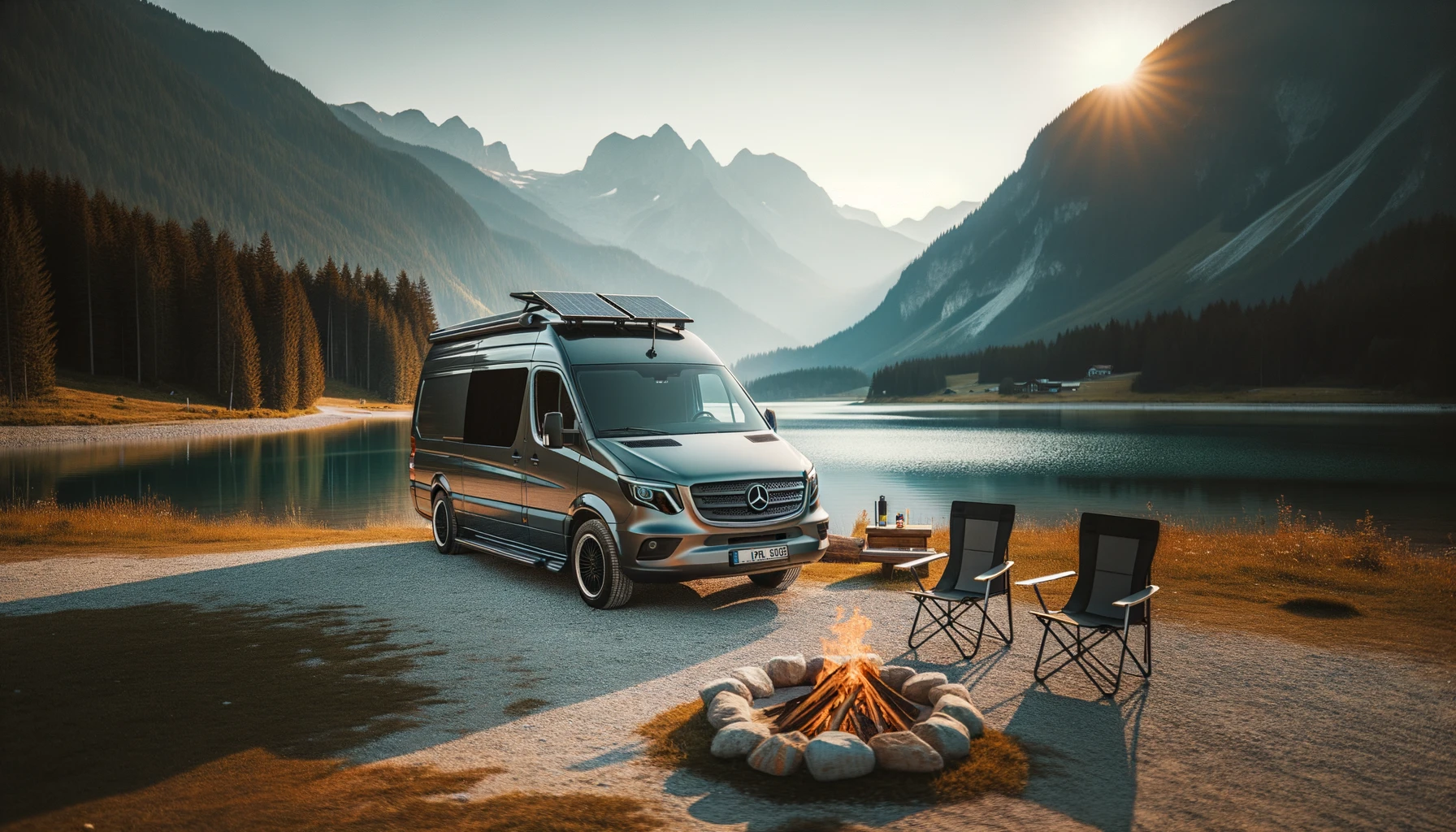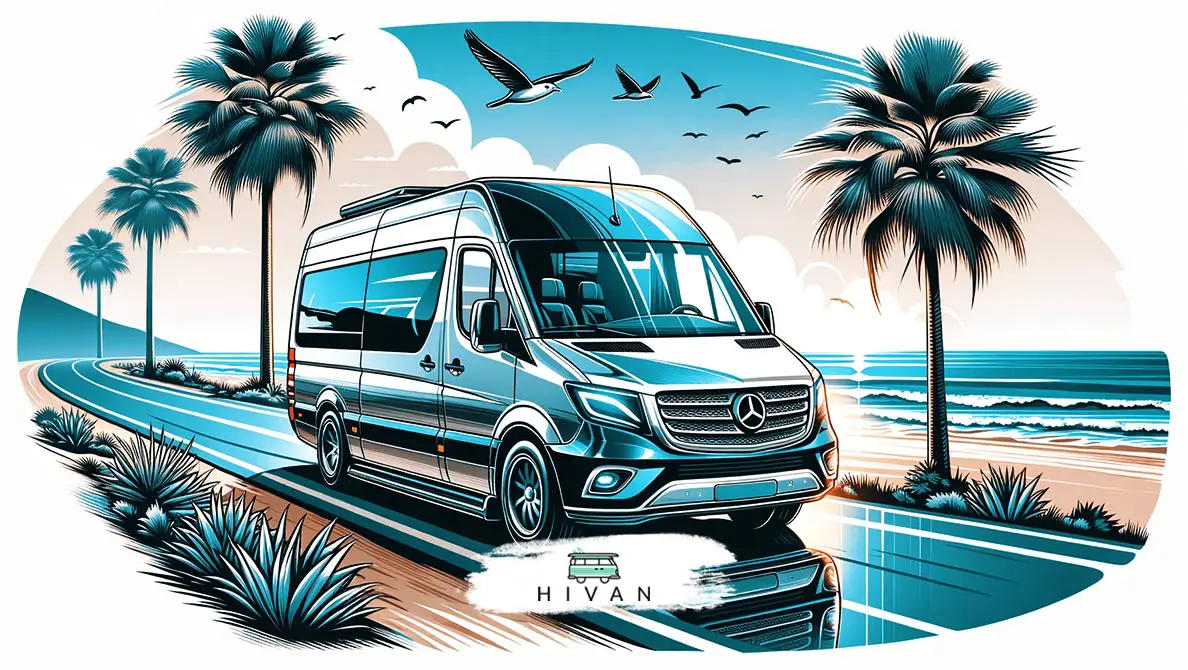So you want to chuck the 9-to-5 rat race and hit the road in a converted van. Sooner or later, you’re going to ask yourself if you can afford the van life. But how do you figure out what you can afford?

To find out how to afford the van life, you need to calculate both obvious and hidden costs. Then, balance the costs against what you can afford to decide your lifestyle choice.
Can You Afford Van Life? Quick Check:
- Estimate initial costs: van purchase + conversion.
- Calculate monthly expenses: gas, maintenance, food, insurance.
- Factor in emergency funds.
- Compare with your monthly income or savings.
- If income > expenses, you’re good to go!
Van lifers often find ways to make money while on the road and find ways to cut down on expenses to achieve their dream.
Sooner or later, you’re going to have to stop scrolling through your Instagram #vanlife hashtags, stop watching YouTube influencers, and sit down and crunch the numbers. This article will guide you through the process.
Obvious and Hidden Costs of Van life
When people plan out a budget for the van life adventure, they usually think of obvious costs, such as food, gas, and how much it’ll cost to park the van. However, other less apparent expenses should also be considered.
Let’s start with the obvious.
How do people afford van life?
Many people afford van life by:
- Saving money beforehand and budgeting carefully during their travels.
- Working remote jobs or pursuing freelance gigs that can be done on the road.
- Reducing regular expenses by living minimally and utilizing free or low-cost camping spots.

Understanding the Costs of Van Life
Initial Costs:
Purchasing a van
The van will be the most considerable up-front expense, but, except for repairs, maintenance, and fuel, it’s a one-time purchase. Prices run the gamut from $10,000 to $15,000 for an old van converted with bed, storage, fridge, and power source to a $80,000+ Sprinter fully converted.
Most van lifers fall somewhere in the middle.
Like a Ford Econoline or Dodge B-Series, Cargo vans are easy to service, have strong motors and drivetrains, and are generally dependable. You should be able to find a van in the $5,000-$10,000 range before conversion.
However, cargo vans are essentially a box on wheels.
Conversion vans share the same chassis as cargo vans, but the upgrades, such as windows, seats that convert into beds, storage space, and sometimes a small food preparation area, make them feel more like home.
Budget-minded van lifers will try to replicate the upgraded conversion vans with DIY projects.
If you hear someone say Euro-style vans, they refer to Sprinters, ProMasters, and other Transit vans. These models are often used as delivery vehicles by companies like Amazon. Because the cab is pushed forward, they have more room for showers, bathrooms, and small kitchen spaces.
Unfortunately, they’re also the most expensive. Expect to pay at least $35,000 for a new Sprinter and then add the additional expense of converting it into a camper.
You might be able to find a used one for $15,000 to $20,000.
If those options are too expensive, consider converting your current vehicle. Smaller vehicles can be converted for life on the road. It might not be roomy, but your main expenses will be the conversion.
Finally, a retired school bus is roomy and has lots of potentials. Drool over these school bus conversions.
![]() Personal tips: If you’re not constraint by time, I’d adivse you to buy a used van and convert it yourself. You’ll learn so many valuable things that will serve you through out all your life on the road.
Personal tips: If you’re not constraint by time, I’d adivse you to buy a used van and convert it yourself. You’ll learn so many valuable things that will serve you through out all your life on the road.
Recurring Costs
Gas

Gas will always be a significant expense as you travel, and budgeting for it is tricky due to fluctuations in gas prices. However, if you know the distance you plan to drive in a month and divide that by the MPG of your van, you know how many gallons of gas or diesel you need.
1,600 miles/14.5 mpg = 110.3 gallons (2,574.95 km/6.16 kmL = 418 L)
Multiply the amount of gas you need by the price of gas to wind up with a rough estimate. For example, if gas is $2.50, the estimate is $275.50 for the month.
Food

Food is another essential, but budgeting for food also gets tricky. Do you have dietary preferences or requirements, or will you be eating out or cooking your meals? You’ll need to factor these in when coming up with a budget.
Start by calculating how much you currently spend on food. You can’t build a budget without knowing how much you spend now.
Keep track of all food expenses for a month, grocery stores, and restaurants. Don’t be surprised if you spend nearly as much on food out as at home. The average American household spends $600 on food, and approximately $260 of that is eating out. If you crunch the numbers some more, the average American spends $7.60 a day on food.
That adds up to $229 a month per person. But a budget-minded person can get that number down to $5 a day, which is $300 for two people.
Sleeping

Some people never sleep at a campground. The U.S. is full of free camping spots, and apps such as The Dyrt have a vast database of campsites (44,000+), reviews from users, and forums to ask questions and get advice.
Sleeping in cities is trickier and requires some planning. You’ll need to call ahead if you want to stay at a particular Walmart or another retailer. Some can no longer allow overnighters due to local ordinances.
Other stores got tired of people turning their parking lots into campgrounds.
The average cost of a Private RV Park is $38.50, while public campgrounds will run you $22.15 per night. Thus, a public campground will cost you $664 a month, although you can significantly bring that price down with discounts.
Still, that’s steep. No wonder van lifers look for free camping spots whenever possible.
The Hidden Costs

RV Insurance
The process for purchasing insurance for a van you plan to live in is different from insuring a car.
First, you have to deal with the requirements of the state where you buy the insurance. But, more importantly, you aren’t insuring just a car, but your home as well.
Besides thinking about deductibles and what coverage to get, another complication is whether your conversion was done by a professional conversion company or yourself. Insurance companies will often hesitate to insure DIY vans because of the difficulty of calculating their value.
![]() Personal tips: If you simply insure your van as a vehicle, you won’t be able to claim any of the upgrades in case of an accident.
Personal tips: If you simply insure your van as a vehicle, you won’t be able to claim any of the upgrades in case of an accident.
You might be tempted to claim your van as a vehicle, not an RV, but insurance companies will consider it an RV if you plan to spend more than six months on the road.
You’ll be committing insurance fraud in that case, and most companies won’t be required to pay out anything.
If your van is a DIY build, then do the following:
- Keep track of all your expenses related to the van.
- Provide the insurer with more information than the vehicle model and Vin number. Unless the provider knows about the mini-fridge, solar panels, or other features you added, they won’t cover the cost.
- Take and keep pictures of the inside and exterior of your van as well as personal items that will be insured.
Insurance prices vary greatly, but budget at least $50 a month.
Phone Bill
You need unlimited data and hotspot access for your phone. Using a low-data phone plan and relying on an internet provider at home won’t work on the road. A phone with unlimited tethering will keep you from having to find a coffee shop every time you need to use your laptop.
Shop around and look for a provider that uses a major network but at a discount.
Visible, for example, uses Verizon’s network but costs far less. Currently, Visible for two people might cost around $70.
Additional expenses
Here are a few additional expenses you might not have thought about:
- Laundry: Sooner or later, you’ll realize that you smell like garbage and need to wash your clothes. Costs vary but figure on $5 per load. Or you can figure your way of installing your own laundry in your van.
- Showers: Some van lifers buy a membership to a fitness center like Planet Fitness. But if you want to avoid cities when possible, then you’ll rely on truck stops and campground showers, and prices vary greatly. Expect to pay a minimum of $10 per shower, although you can lower that by using loyalty programs. I made a full guide here: Showering on the road – Full Guide
- Activities: If your thing is spending days hiking, your activity expenses will be the entrance price to a park or a parking space for a day hike. An annual pass for all National Parks is currently $80. The Plan Your Visit page lists over 1,000 parks by state. If you plan to go to concerts or visit an art museum, you need to budget more. $50 to $100 seems reasonable for miscellaneous costs.
Maintenance and Unexpected Expenses
It’s impossible to predict if you’ll need to buy new brakes, get an oil change, or getting sick. Some months everything will go according to plan, but you can’t predict when something breaks and sets you back a couple of hundred dollars.
Therefore, it’s best to budget for unexpected expenses. Budget $200-$250 a month to be safe.
Lifestyle Choices for Van Living
To achieve the van life, you need to weigh your lifestyle choices against your budget. Sometimes we must tighten our belts, and at other times we can splurge. Most van lifers fit into one of these lifestyle categories.
Frugal – $1000/month
A frugal lifestyle usually includes driving an older camper or pop-up camper, staying at free campsites, saving gas by traveling infrequently, and keeping food costs low. In addition, to keep power costs down, frugal van lifers typically avoid areas with temperature extremes and minimize electronic devices.
A $1000 monthly budget should be doable for the frugal van lifers. Check out Cheap RV Living for more frugal tips and ideas.
Budget – $1,200-1500/month
If you want to add an occasional meal out, splurge on a souvenir or movie, and spend a night or two in a campground, then you’re a budget van lifer. You’ll still do most of your cooking and go to cheap parks and other activities.
Budget $1,200-1,500 for this lifestyle.
Comfortable – $2,000/month
If you have $2,000+ to spend monthly, you can live life comfortably in a van. What does that mean?
Eating out more, spending more nights at campsites, and not counting every penny. A comfortable lifestyle means you can afford to travel more frequently and do more touristy things. These numbers are rough estimates and can change.
The point is that you don’t have to abandon your dream for the van life, but you might need to rethink your lifestyle.
Find this content useful 🙂 ?
Subscribe to our Newsletter and get a free Solar Electric Diagram + shopping list.
Income Opportunities for Van Lifers
Paying for the van lifestyle requires that you be independently wealthy, have enough savings to spend a few years trying it out, can live on retirement or pension payouts, or are willing to search for side hustles or temporary, seasonal work.
If you’re independently wealthy, then, of course, you can afford the van life. But many van lifers resort to earning money while on the road, such as remote work, seasonal work, and side hustles. For example, you might spend a few months working in a park and use that money to finance the rest of your travels.
Remote Work
If your current employer will let you work remotely, consider yourself lucky. Even with Covid, most employers want their employees to be available to go to the worksite. But it doesn’t hurt to ask.
Most remote work is freelance work where you hunt up jobs, often through job boards. The following are just a few suggestions, head over to my list of 40+ Ideas to make money on the road. But without reliable internet access, it won’t be easy to make consistent money.
Here are some of the remote work you can do:
- Freelance writing: Every day around 7.5 million blog posts are published, and somebody has to write all that content. If you can write clearly, then look for opportunities for freelance writing on sites such as Upwork.
- Online test grader: Along with online test graders, if you have a degree, you can also sign up for online tutoring.
- Transcriptions: A transcriptionist takes the spoken word and turns it into text. For example, a medical background will let you transcribe a doctor’s notes. Subtitles and closed captions for television, movies, and videos are transcription opportunities that don’t require specialized knowledge.
- Data entry: Companies outsource data entry to cut expenses. Freelance data entry gigs are easy to start.
- Website development or programming/coding: Both coding and website development requires a knowledge of computer languages. Of course, you can teach yourself to code and design websites, but is that how you want to spend your days on the road?
Seasonal Work
Seasonal work includes spending several weeks working on a farm, part-time work at national parks, or retail work and restaurant work in tourist towns when the businesses need more workers.
Opportunities like these are often word-of-mouth, but if skiing is your passion, what could be better than working a winter at a resort?
Side Gigs
Side hustles are gigs that you can pick up whenever you’re up to it. It’s sort of like seasonal work, except you can do it for a day or two, and it isn’t dependent on location.
Uber and Lyft are two popular side hustles for anyone planning to spend some time in a city. Van lifers who do this rarely use their vans. Instead, they drive rental cars, which is legal in most areas.
If you don’t want to ferry people around all day, food delivery is another option. Door Dash and similar restaurant delivery services are ideal for those towing a car. If you have a bike and stay in a bigger city, you can make some money while exercising.
Grocery delivery or in-store shopping through services like InstaCart put fewer miles on your van.
Essential Tips for Financial Sustainability on the Road

Here are some vital tips to help you maintain financial sustainability while enjoying the nomadic lifestyle.
Save Money for an Emergency Fund

One of the foremost considerations for any van lifer is establishing an emergency fund.
The unpredictable nature of life on the road means that unexpected expenses can crop up at any time, be it a sudden van breakdown, medical emergencies, or unplanned detours.
Having a financial safety net ensures that these hiccups don’t derail your journey or plunge you into debt.
![]() As a rule of thumb, aim to save at least three to six months’ worth of living expenses.
As a rule of thumb, aim to save at least three to six months’ worth of living expenses.
This fund should be easily accessible, but separate from your daily spending account, ensuring you only tap into it during genuine emergencies.
Insurance and Health
Traveling in a van brings its own set of risks. From potential accidents to theft, it’s crucial to have an insurance plan that covers both you and your vehicle.
Shop around for plans, consider factors like coverage limits, deductibles, and customer reviews. Remember, the cheapest plan might not always offer comprehensive protection.
![]() Personal tips: we created a whole article about insurance for nomadic lifestyle. Check it out here.
Personal tips: we created a whole article about insurance for nomadic lifestyle. Check it out here.
Your health is your most valuable asset.
Consider setting up a health savings account (HSA) if you’re eligible, which allows you to set aside pre-tax dollars for medical expenses.
Additionally, always carry a basic first-aid kit, and familiarize yourself with local medical facilities as you travel. Regular check-ups and staying updated with vaccinations can also go a long way in ensuring a healthy journey.
Networking with Other Van Lifers
The van life community is vast and incredibly supportive. Engaging with fellow van lifers can open doors to a wealth of resources, tips, and even job opportunities.
Platforms like forums, social media groups, and van life meet-ups can be great places to connect.
Sharing experiences, pooling resources for bulk purchases, or even collaborating on projects can be mutually beneficial.
Remember, while the road might sometimes feel lonely, you’re part of a larger community that thrives on mutual support and shared experiences.
How To Save Money Living the Van Life

If you’re short of money and down to one can of baked beans at the end of the month, you need to tighten your belt a little more. Instead of dipping into your unexpected expenses fund, see if any of these suggestions apply to you.
1. Track Your Expenses
Track your expenses so you know where your money is going. Your costs won’t be as predictable as living in a house or apartment. Find out where your money is going, and you may find out if you’re eating out more often than you realize.
Check out free apps like Mint for budgeting help.
2. Max Fuel Efficiency
Fuel efficiency isn’t just about mpg or kpl. It includes things like keeping tires inflated to the correct pressure, driving at lower speeds, and planning routes that get you from point A to point B most efficiently.
Keep in mind that sometimes taking a longer, less congested route can save fuel and time over sitting in traffic. An app like GasBuddy will keep you from spending $3.50 on fuel only to discover fuel selling for $2.79 ten miles later.
3. Be a Smart Shopper
Being a savvy shopper means more than looking for sales. It starts with planning your meals so you buy what you need. Then, buy generic brands and give yourself permission to splurge on one or two items to avoid feeling deprived.
Some van lifers purposely leave room in their vans so they can buy in bulk at Costco. Others look for shops like Aldi or outlet grocery stores (google “grocery outlet near me” for nearby outlets).
4. Avoid Places Where You Do Impulse Buying
You know what we mean. There’s at least one store where you can’t stop yourself from buying something. It might be a tourist shop, a museum store, or a discount mall, but whatever that place is, avoid it if you need to tighten your belt.
5. Learn Basic Maintenance
Learning how to check for fluids, change a tire, and do other minor maintenance can save you from having to pay someone else. If your build is a DIY, you probably know how to do this. Look for informative YouTube videos can be informative, such as this one about the dangers of buying cheap parts:
Conclusion
Nothing beats the van life. However, like any lifestyle, it requires careful financial planning and adaptability to ensure sustainability.
We’ve provided a roadmap to financially sustainable van living, but every traveler’s journey is unique.
Perhaps you’ve discovered ingenious ways to save money or found exciting job opportunities on the road.
We invite you to share your insights, tips, and stories in the comments below. Or, if you have questions or need further advice, don’t hesitate to ask. Together, as a community, we can enrich the van life experience for all.
Find this content useful 🙂 ?
Subscribe to our Newsletter and get a free Solar Electric Diagram + shopping list.

